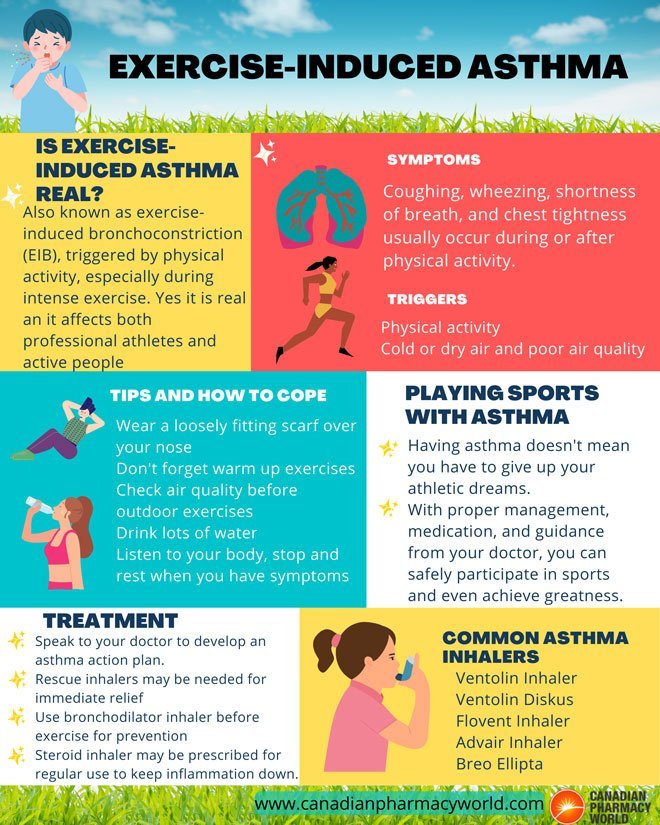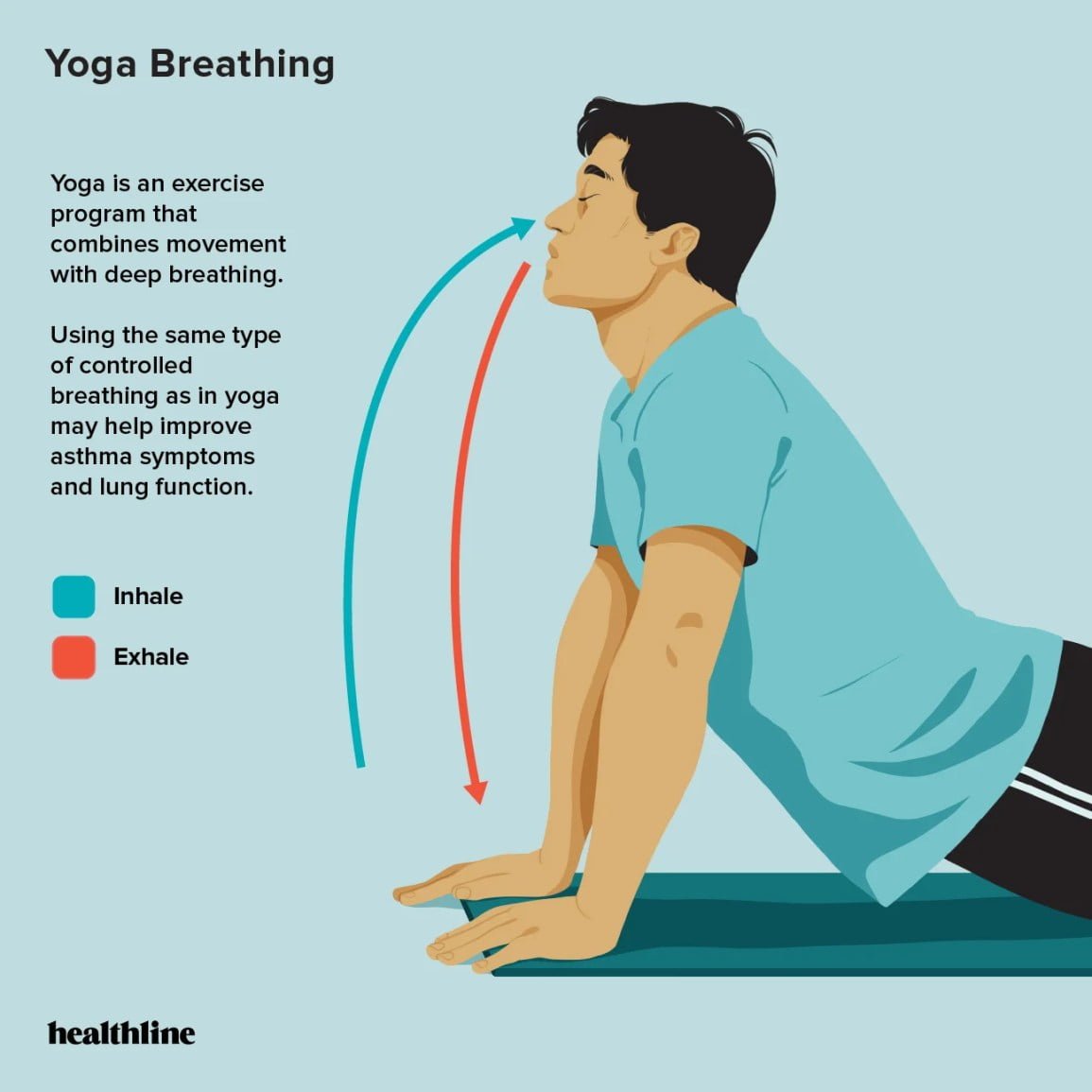
If you have asthma, you may be wondering how you can safely participate in physical activity or exercise without triggering an attack. The good news is that with proper precautions and management, individuals with asthma can still enjoy an active lifestyle. From choosing the right type of exercise to ensuring you have quick-relief medication on hand, this article provides tips and strategies to help you safely engage in physical activity and exercise while managing your asthma effectively. So, let’s dive in and explore how you can stay active and keep your asthma under control at the same time!
Consult with your healthcare provider before starting any exercise program
Before embarking on any exercise program, it is crucial to consult with your healthcare provider, especially if you have asthma. Your healthcare provider will be able to assess your current health status and provide guidance on how to safely engage in physical activity. They can also evaluate your asthma triggers, discuss exercise plans, and make any necessary adjustments to your medication.
Understand your asthma triggers
Asthma triggers vary from person to person, so it is important to understand and identify your individual triggers. Triggers can include allergens such as pollen, dust mites, or animal dander, as well as irritants like smoke or strong odors. Some individuals may also experience exercise-induced asthma, where physical activity triggers asthma symptoms. By knowing your triggers, you can take steps to avoid or minimize exposure to them, making your exercise routine more enjoyable and safe.
Discuss your exercise plans with your healthcare provider
Once you have identified your asthma triggers, it is essential to discuss your exercise plans with your healthcare provider. They will be able to evaluate the suitability of different activities based on your specific triggers. By discussing your plans, you can create an exercise routine that minimizes the risk of triggering asthma symptoms and maximizes the benefits of physical activity for your overall health.
Get a proper diagnosis and treatment plan
To ensure you are exercising safely with asthma, it is crucial to have a proper diagnosis and treatment plan in place. Your healthcare provider will evaluate your symptoms, perform necessary tests, and develop an individualized treatment plan. This may include medication to manage symptoms and prevent asthma attacks. With a proper diagnosis and treatment plan, you can exercise with peace of mind knowing that you are taking the necessary precautions to keep your asthma under control.
Adjust your medication if necessary
As part of your treatment plan, your healthcare provider may need to adjust your medication regimen to accommodate physical activity. This could involve increasing the dose of certain medications or adding new ones to manage exercise-induced symptoms. It is essential to follow your healthcare provider’s instructions regarding medication use and inform them of any changes in your symptoms or exercise routine. By making adjustments to your medication, you can ensure that your asthma remains well-controlled during exercise.

Choose appropriate activities
When selecting exercises, it is important to choose activities that are suitable for individuals with asthma. While asthma should not limit your ability to engage in physical activity, certain activities may be more asthma-friendly than others. Focus on aerobic exercises that promote cardiovascular health, such as brisk walking, jogging, or dancing. These activities can improve lung function and overall fitness without causing excessive strain on your respiratory system.
Avoid activities with high intensity
While aerobic exercises are generally well-tolerated, it is important to avoid activities with high intensity that may put excessive stress on your lungs. Activities such as sprinting, basketball, or soccer may trigger asthma symptoms in some individuals. Instead, opt for low to moderate intensity exercises that allow you to maintain a comfortable breathing pattern throughout the activity.
Consider swimming or cycling
Swimming and cycling are often considered excellent choices for individuals with asthma. They are both low-impact activities that promote cardiovascular fitness without causing excessive strain on the respiratory system. Swimming, in particular, is beneficial for individuals with asthma as the warm, moist air is less likely to trigger symptoms compared to dry, cold air found in other environments.
Incorporate flexibility and strength training exercises
In addition to aerobic exercises, it is important to incorporate flexibility and strength training exercises into your routine. These exercises can help improve overall muscle strength, flexibility, and posture, which can have a positive impact on your asthma management. Yoga, Pilates, or tai chi are examples of low-impact activities that can help enhance flexibility, while resistance training with weights or resistance bands can improve muscle strength. Be sure to start with light weights or resistance and gradually increase as your fitness level progresses.
Listen to your body
When exercising with asthma, it is crucial to listen to your body and pay attention to any warning signs or symptoms. Start slowly and gradually increase the intensity of your workouts over time. Pushing yourself too hard too quickly can increase the likelihood of triggering asthma symptoms. If you experience shortness of breath, coughing, wheezing, chest tightness, or fatigue during exercise, it is important to stop, take a break, and assess your symptoms.

Pay attention to warning signs
Knowing the warning signs of worsening asthma symptoms is essential to ensure your safety during physical activity. If you notice that your symptoms are worsening or becoming more frequent during exercise, it may be an indication that your asthma is not well-controlled. Additionally, be mindful of any new or unusual symptoms that may arise during or after exercise, as these can also be warning signs of poorly managed asthma. If you experience repeated or severe asthma symptoms, it is important to seek medical attention promptly.
Don’t push yourself too hard
While it is important to challenge yourself during exercise, it is equally important not to push yourself too hard. Overexertion can increase the risk of triggering asthma symptoms and lead to unnecessary strain on your respiratory system. Pace yourself and find a comfortable level of intensity that allows you to enjoy the activity without putting undue stress on your lungs.
Take breaks when needed
Taking breaks during exercise is essential, especially if you start to experience any asthma symptoms. Resting allows your body to recover and catch its breath, preventing the exacerbation of symptoms. If you feel that you need a break, it is important to listen to your body and take the necessary time to rest and recover before continuing with your workout.
Warm up and cool down properly
Properly warming up and cooling down before and after exercise can help prepare your body and reduce the risk of asthma symptoms. Prior to exercising, perform a 5-10 minute warm-up that includes light aerobic activity such as walking or gentle stretching. This helps gradually increase your heart rate and body temperature. After your workout, cool down by performing low-intensity exercises and stretching to gradually bring your heart rate and breathing back to normal.
Perform a 5-10 minute warm-up before exercising
Warming up before exercise is essential, as it helps prepare your body for the upcoming physical activity. A warm-up should consist of 5-10 minutes of low-impact aerobic activity, such as walking, stationary cycling, or light jogging. This increases blood flow to the muscles and helps improve flexibility, reducing the risk of injury and asthma symptoms during exercise.

Include stretching exercises in your warm-up and cool-down
In addition to light aerobic activity, incorporating stretching exercises in your warm-up and cool-down routine can help improve flexibility, prevent muscle strain, and reduce the risk of asthma symptoms. Focus on stretching major muscle groups such as your calves, quadriceps, hamstrings, and upper body. Remember to perform each stretch gently and hold it for 15-30 seconds without bouncing.
Allow yourself time to recover after physical activity
After completing your workout, it is essential to allow your body time to recover. This includes cooling down with low-intensity exercises and performing post-workout stretching. Adequate recovery time allows your heart rate and breathing to gradually return to normal, reducing the likelihood of triggering asthma symptoms after exercise. Be sure to hydrate and listen to your body’s cues for rest and recovery.
Use asthma medications as prescribed
To maintain control of your asthma symptoms during exercise, it is crucial to take your medications as prescribed by your healthcare provider. This may include long-term control medications to manage symptoms on a daily basis, as well as quick-relief inhalers to provide immediate relief during exercise. By following your medication regimen, you can significantly reduce the risk of asthma symptoms interfering with your physical activity.
Take your medication as directed by your healthcare provider
Adhering to your healthcare provider’s instructions regarding medication use is vital for managing your asthma effectively during exercise. This may involve taking medications at specific times or adjusting doses based on your activity level. It is important to have a clear understanding of how and when to take your medications, as well as any potential side effects or precautions to be aware of.
Use a bronchodilator before exercise if recommended
In some cases, your healthcare provider may recommend using a bronchodilator before exercise. A bronchodilator is a type of medication that helps relax and open up the airways, making it easier to breathe during physical activity. If this is recommended for you, make sure to follow your healthcare provider’s instructions on when and how to use the bronchodilator, as it can help prevent exercise-induced asthma symptoms.

Always carry a quick-relief inhaler with you
It is essential to always carry a quick-relief inhaler, also known as a rescue inhaler, with you when engaging in physical activity. This inhaler contains medication that provides immediate relief from asthma symptoms. Having your inhaler readily available allows you to quickly manage any unexpected symptoms during exercise, ensuring your safety and well-being.
Take precautions in certain environments
Certain environments can pose additional challenges for individuals with asthma. To exercise safely, it is important to take precautions in these situations. Avoid exercising in cold, dry, or heavily polluted air, as these conditions can trigger asthma symptoms. If extreme weather conditions make outdoor exercise uncomfortable or unsafe, consider exercising indoors instead. Additionally, be cautious when exercising at high altitudes, as the lower oxygen levels may affect your breathing.
Avoid exercising in cold, dry, or polluted air
When exercising with asthma, it is best to avoid environments with cold, dry, or polluted air. These conditions can irritate your airways and trigger asthma symptoms. If you must exercise outdoors in these conditions, consider wearing a scarf or face mask to help warm and moisten the air you breathe. However, if you find that your symptoms worsen despite these measures, it is advisable to seek alternative indoor exercise options.
Exercise indoors during extreme weather conditions
During extreme weather conditions, such as extreme heat or cold, it is important to prioritize your safety and exercise indoors. Extreme temperatures can make it difficult to breathe and increase the risk of asthma symptoms. Utilize indoor gyms, fitness centers, or even exercise videos at home to stay active and avoid any potential triggers associated with extreme weather.
Be cautious when exercising in high altitudes
If you plan to exercise in high-altitude areas, such as mountains or high-elevation destinations, it is important to be cautious and aware of the potential effects on your asthma. At higher altitudes, the air becomes thinner and oxygen levels decrease, which can make breathing more challenging. If you are not acclimated to high altitudes, start with lower intensity activities, take frequent breaks, and listen to your body’s signals. If you experience worsening asthma symptoms, it may be necessary to adjust your exercise routine or consider alternative lower-altitude locations.

Monitor your symptoms
Regularly monitoring your asthma symptoms is important for maintaining control and ensuring your safety during exercise. Pay attention to any changes in your breathing, such as wheezing, coughing, shortness of breath, or chest tightness. These symptoms can indicate that your asthma is not well-controlled or that you may need to adjust your medication. By monitoring your symptoms, you can take appropriate action and seek medical attention if necessary.
Pay attention to changes in your breathing
During exercise, it is important to pay close attention to your breathing patterns. If you find that your breathing becomes increasingly difficult or you experience a change in your normal breathing pattern, it may be a sign that your asthma is being triggered. Addressing these changes promptly can help prevent the escalation of symptoms and allow you to continue exercising safely.
Track your peak flow readings
Peak flow readings are a useful tool for monitoring your lung function and asthma control. A peak flow meter is a handheld device that measures how quickly you can exhale air from your lungs. By tracking your peak flow readings before and after exercise, you can assess any changes in your lung function and identify potential triggers or worsening symptoms. This information can be shared with your healthcare provider to help guide your asthma management during exercise.
Keep a symptom diary
Keeping a symptom diary can provide valuable insights into your asthma triggers and the effectiveness of your treatments. Record any asthma symptoms you experience during or after exercise, as well as the details of your exercise routine, including the duration, intensity, and environment. This record can help you identify patterns and make informed decisions about your exercise routine, such as modifying activities or adjusting medication doses.
Seek medical attention if symptoms worsen
If your symptoms worsen during or after exercise, it is important not to ignore them. Experiencing severe or persistent asthma symptoms can indicate inadequate control of your condition. If your symptoms are impacting your ability to exercise or are accompanied by other concerning signs, such as difficulty speaking in full sentences or bluish lips or fingernails, it is crucial to seek medical attention promptly to assess your asthma management and make necessary adjustments.
Learn and practice proper breathing techniques
Proper breathing techniques can help improve your asthma control during exercise. Focusing on slow, controlled breathing can help prevent hyperventilation and reduce the risk of triggering asthma symptoms. Incorporating diaphragmatic breathing, where you breathe deeply using your diaphragm instead of shallow chest breathing, can enhance lung function and increase oxygen intake. Pursed lip breathing, where you exhale slowly through pursed lips, can also help regulate breathing and prevent airway collapse during exercise.
Focus on slow, controlled breathing
During exercise, it is important to maintain a slow and controlled breathing pattern. Rapid, shallow breathing can increase the likelihood of triggering asthma symptoms. Focus on inhaling deeply through your nose and exhaling slowly and completely through your mouth. This controlled breathing technique helps regulate your respiratory rate and prevents hyperventilation, ensuring a more comfortable and enjoyable exercise experience.
Incorporate diaphragmatic breathing
Diaphragmatic breathing, also known as belly breathing, is a technique that helps engage your diaphragm and increase lung capacity. To practice diaphragmatic breathing, place one hand on your abdomen, just below your ribcage, and the other on your chest. Take a slow breath in through your nose, allowing your abdomen to rise and expanding your lungs as much as possible. Exhale slowly through your mouth and feel your abdomen gently deflate. This technique can help optimize your breathing during exercise and reduce the risk of asthma symptoms.
Use pursed lip breathing during exercise
Pursed lip breathing is a breathing technique that can help regulate your breathing and prevent airway collapse during exercise. To practice pursed lip breathing, gently inhale through your nose for a count of two, then purse your lips as if you were going to blow out a candle, and exhale slowly through your mouth for a count of four. This technique helps create backpressure in the airways, keeping them open and allowing for a more controlled and efficient exhalation. Using pursed lip breathing during exercise can help reduce the likelihood of triggering asthma symptoms and maintain a steady airflow.
Be prepared for emergencies
While exercising with asthma is generally safe, it is important to be prepared for emergencies. This includes having a current asthma action plan that outlines steps to take in case of an asthma attack. Carry a copy of your plan with you during exercise, as well as any necessary rescue medications. It is also important to inform your exercise partners or trainers about your asthma and ensure they are familiar with the signs and symptoms of an asthma attack. Finally, know how to use your inhaler properly to ensure quick and effective relief in case of an emergency.
Carry your asthma action plan with you
An asthma action plan is a written document that outlines your personalized steps for managing asthma symptoms and exacerbations. It includes instructions on when and how to adjust medication use, as well as when to seek medical attention. It is essential to always carry a copy of your asthma action plan with you during exercise. This ensures that you and those around you are aware of the necessary steps to take in case of an emergency.
Inform your exercise partners about your condition
When exercising with asthma, it is important to inform your exercise partners or trainers about your condition. Educate them about the signs and symptoms of an asthma attack and provide them with information on how to assist you if needed. This could involve helping you find your quick-relief inhaler or alerting medical professionals in case of an emergency. By ensuring others are familiar with your asthma, you can exercise with confidence knowing that you have a support system in place.
Know how to use your inhaler properly
Understanding how to use your inhaler properly is essential for effective asthma management during exercise. Different types of inhalers have specific instructions for use, so it is important to follow the guidance provided by your healthcare provider. Practice using your inhaler regularly to ensure you are comfortable and proficient in its use. If you have any questions or concerns, consult your healthcare provider or pharmacist for additional guidance.
Join a support network or group
Living with asthma can sometimes be challenging, but connecting with others who have asthma can provide valuable support, shared experiences, and tips for managing your condition during exercise. Consider joining a support network or group specifically for individuals with asthma or respiratory conditions. These communities can offer motivation, encouragement, and a sense of camaraderie as you navigate exercising safely with asthma.
Connect with others who have asthma
Connecting with others who have asthma can provide a sense of belonging and understanding. Look for local support groups or online communities where you can share your experiences, ask questions, and learn from others in similar situations. Hearing about the challenges and triumphs of fellow asthma sufferers can be inspiring and provide valuable insights into managing your own condition during exercise.
Share experiences and tips
Within support networks or groups, take the opportunity to share your experiences and tips with others who have asthma. By sharing your successes and challenges, you can inspire and help others overcome their own obstacles. Likewise, ask questions and be open to learning from the experiences of others. This exchange of knowledge and support can foster a supportive and empowering community.
Get motivation and encouragement
Finding motivation and encouragement can be a key factor in staying committed to your exercise routine. Connecting with others who have asthma can provide the necessary encouragement and understanding to keep you motivated. Share your exercise goals, achievements, and setbacks with your support network. Together, you can cheer each other on, celebrate milestones, and provide strength during challenging times.
In conclusion, with proper planning, precautions, and support, individuals with asthma can safely engage in physical activity and exercise. By consulting with your healthcare provider, understanding your triggers, choosing appropriate activities, and listening to your body, you can create a tailored exercise routine that keeps your asthma under control while promoting overall health and well-being. Remember to follow your healthcare provider’s instructions regarding medication use, monitor your symptoms, and be prepared for emergencies. By joining a support network, you can connect with others who have asthma, share experiences, and find motivation and encouragement to stay active. With these strategies in place, you can enjoy the many benefits of physical activity while effectively managing your asthma.








